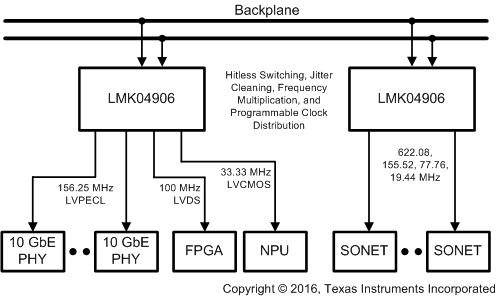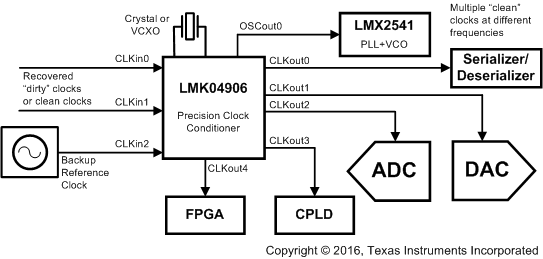ZHCSAX1F June 2012 – August 2017 LMK04906
PRODUCTION DATA.
- 1 特性
- 2 应用
- 3 说明
- 4 修订历史记录
- 5 Pin Configuration and Functions
- 6 Specifications
- 7 Parameter Measurement Information
-
8 Detailed Description
- 8.1
Overview
- 8.1.1 System Architecture
- 8.1.2 PLL1 Redundant Reference Inputs (CLKin0/CLKin0*, CLKin1/CLKin1*, and CLKin2/CLKin2*)
- 8.1.3 PLL1 Tunable Crystal Support
- 8.1.4 VCXO/Crystal Buffered Outputs
- 8.1.5 Frequency Holdover
- 8.1.6 Integrated Loop Filter Poles
- 8.1.7 Internal VCO
- 8.1.8 External VCO Mode
- 8.1.9 Clock Distribution
- 8.1.10 0-Delay
- 8.1.11 Default Start-Up Clocks
- 8.1.12 Status Pins
- 8.1.13 Register Readback
- 8.2 Functional Block Diagram
- 8.3
Feature Description
- 8.3.1 Serial MICROWIRE Timing Diagram
- 8.3.2 Advanced MICROWIRE Timing Diagrams
- 8.3.3 Inputs / Outputs
- 8.3.4 Input Clock Switching
- 8.3.5 Holdover Mode
- 8.3.6 PLLs
- 8.3.7 Status PINS
- 8.3.8 VCO
- 8.3.9 Clock Distribution
- 8.3.10 0-Delay Mode
- 8.3.11 Hitless Switching
- 8.4 Device Functional Modes
- 8.5 Programming
- 8.6
Register Maps
- 8.6.1 Register Map and Readback Register Map
- 8.6.2 Default Device Register Settings After Power On Reset
- 8.6.3
Register Descriptions
- 8.6.3.1
Register R0 to R5
- 8.6.3.1.1 CLKoutX_PD, Powerdown CLKoutX Output Path
- 8.6.3.1.2 CLKoutX_OSCin_Sel, Clock Output Source
- 8.6.3.1.3 CLKoutX_ADLX_SEL[29], CLKoutX_ADLX_SEL[28], Select Analog Delay
- 8.6.3.1.4 CLKoutX_DDLY, Clock Channel Digital Delay
- 8.6.3.1.5 Reset
- 8.6.3.1.6 POWERDOWN
- 8.6.3.1.7 CLKoutX_HS, Digital Delay Half Shift
- 8.6.3.1.8 CLKoutX_DIV, Clock Output Divide
- 8.6.3.2 Registers R6 to R8
- 8.6.3.3 Register R10
- 8.6.3.4 REGISTER R11
- 8.6.3.5 Register R12
- 8.6.3.6 Register R13
- 8.6.3.7 Register 14
- 8.6.3.8 Register 15
- 8.6.3.9 Register 16
- 8.6.3.10 Register 23
- 8.6.3.11
Register 24
- 8.6.3.11.1 PLL2_C4_LF, PLL2 Integrated Loop Filter Component
- 8.6.3.11.2 PLL2_C3_LF, PLL2 Integrated Loop Filter Component
- 8.6.3.11.3 PLL2_R4_LF, PLL2 Integrated Loop Filter Component
- 8.6.3.11.4 PLL2_R3_LF, PLL2 Integrated Loop Filter Component
- 8.6.3.11.5 PLL1_N_DLY
- 8.6.3.11.6 PLL1_R_DLY
- 8.6.3.11.7 PLL1_WND_SIZE
- 8.6.3.12 Register 25
- 8.6.3.13 Register 26
- 8.6.3.14 Register 27
- 8.6.3.15 Register 28
- 8.6.3.16 REGISTER 29
- 8.6.3.17 Register 30
- 8.6.3.18 Register 31
- 8.6.3.1
Register R0 to R5
- 8.1
Overview
-
9 Application and Implementation
- 9.1
Application Information
- 9.1.1 Loop Filter
- 9.1.2 Driving CLKin and OSCin Inputs
- 9.1.3 Termination and Use of Clock Output (Drivers)
- 9.1.4 Frequency Planning With the LMK04906 Family
- 9.1.5 PLL Programming
- 9.1.6 Digital Lock Detect Frequency Accuracy
- 9.1.7 Calculating Dynamic Digital Delay Values For Any Divide
- 9.1.8 Optional Crystal Oscillator Implementation (OSCin/OSCin*)
- 9.2 Typical Application
- 9.3 System Examples
- 9.4 Do's and Don'ts
- 9.1
Application Information
- 10Power Supply Recommendations
- 11Layout
- 12器件和文档支持
- 13机械、封装和可订购信息
1 特性
- 超低均方根 (RMS) 抖动性能
- 100fs RMS 抖动(12kHz 至 20MHz)
- 123fs RMS 抖动(100Hz 至 20MHz)
- 双环路 PLLatinum™锁相环 (PLL) 架构
- PLL1
- 集成低噪声晶体振荡器电路
- 输入时钟丢失时采用保持模式
- 自动或手动触发/恢复
- PLL2
- 标准 [1Hz] PLL 本底噪声 -227dBc/Hz
- 相位检测器速率高达 155MHz
- OSCin 倍频器
- 集成式低噪声压控振荡器 (VCO)
- PLL1
- 3 个具有 LOS 的冗余输入时钟
- 自动和手动切换模式
- 50% 占空比输出分配,1 至 1045(偶数和奇数)
- 低电压正射极耦合逻辑 (LVPECL),低压差分信令 (LVDS) 或低电压互补金属氧化物半导体 (LVCMOS) 可编程输出
- 精密数字延迟,固定或动态可调
- 25ps 步长模拟延迟控制。
- 6 个差分输出。高达 12 个单端输出。
- 多达 5 个 VCXO / 晶振缓冲输出
- 高达 2600MHz 的时钟速率
- 0 延迟模式
- 加电时 3 个缺省时钟输出
- 多模式:双 PLL,单 PLL 和时钟分配
- 工业温度范围:–40°C 至 85°C
- 3.15V 至 3.45V 工作电压
- 封装:64 引脚 WQFN (9mm × 9mm × 0.8mm)
2 应用
- 10G、40G 和 100G OTN 线板卡
- 同步光网络/同步数字体系 (SONET/SDH) OC-48/STM-16 和 OC-192/STM-64 线卡
- GbE/10GbE,1/2/4/8/10GFC 线卡
- 国际电信联盟 (ITU) G.709 和定制前向纠错 (FEC) 线卡
- 同步以太网
- 光纤模块
- 数字用户线路接入复用器 (DSLAM) / 综合业务接入网 (MSAN)
- 测试和测量
- 广播视频
- 无线基站
- 数据转换器计时
- 针对无线回程的微波室外发送/接收装置 (ODU) 和室内发送/接收装置 (IDU)
3 说明
LMK04906 是业界性能突出的时钟抖动衰减器,具备满足高性能计时应用需求的高级 功能, 可实现优异的时钟抖动消除、时钟生成和分配。
LMK04906 接受 3 个时钟输入,范围从 1kHz 到 500MHz,可生成 6 个唯一的时钟输出频率,范围从 284kHz 至 2.6GHz。LMK04906 也可缓冲一个晶振或 VCXO,用于生成第 7 个唯一时钟频率。
该器件几乎可提供 SONET、以太网、光纤通道和多模式无线基站所需的所有频率转换组合。
LMK04906 输入时钟频率和时钟倍频比可通过一个 SPI 接口编程。
器件信息(1)
| 器件型号 | VCO 频率 | 基准输入 |
|---|---|---|
| LMK04906 | 2370MHz 至 2600MHz | 3 |
- 如需了解所有可用封装,请参阅产品说明书末尾的可订购产品附录。
系统应用图

简化 LMK04906 方框图
